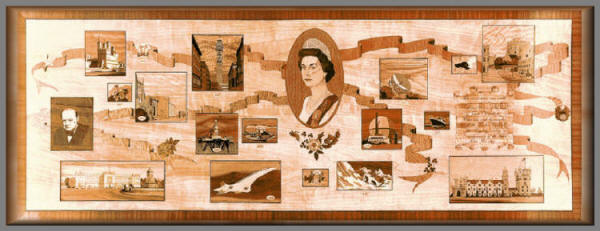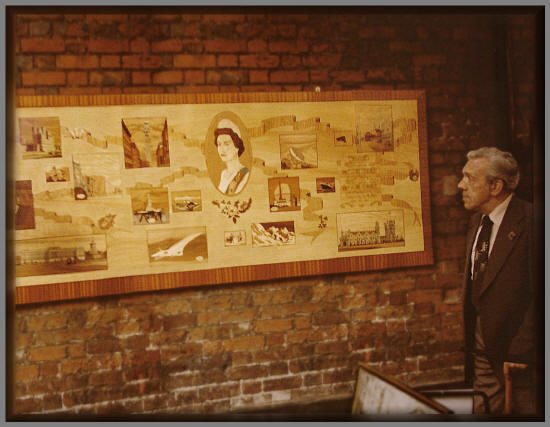|
Now let’s go back once again to the beginning.
Members of the Group chose the particular picture or
pictures they would like to do, and so we began. A
suitable background was chosen. This wasn’t easy as
pieces of veneer of over three feet wide and nine feet
long just don’t grow on trees (sorry, I’ll rephrase
that) are not so easy to come by; at least not that
which would be suitable for the kind of background we
had in mind.
Two pieces of 18 inch wide Aspen turned end to end gave
us the answer. They were then joined together by glue
stitching (a method of joining used in the veneer
trade).
We now
come to the problem of transport. As we could not leave
the mural at our clubroom it had to be brought to and
from Malet Street.
It was
done in this way: The veneer was taped to a piece of
3/8” plywood and this in turn was put into a large
plastic envelope to prevent the weather getting to it,
and this was then tied to the roof rack of Mr. Good’s
car. For eight or so group meetings it was shuttled back
and forth so we could offer up our completed or near
completed pictures to the background. When at last the
final positions of the pictures were settled, Mr. Good
began to cut them in.
This was done in a hastily set up workroom (i.e. his
front room). It was the only place large enough to lay
the mural flat.
When this was completed an ebony stringer was added,
then the crossbanded border of Nigerian Walnut fixed
into position and finally an edging of Macassar Ebony
all the way round. We were now ready for the laying.
This was to be done by the firm of F.R. Shadbolt & Son.
A day was fixed for Charlie and myself to be there while
the mural was being laid, and speaking for myself, it
was an experience not to be missed.
The first step was to prepare the baseboard. This was to
be of one inch blockboard cut to size with a solid
Nigerian Walnut edging glued all around. It was then
trimmed to a quarter of an inch larger all round than
the mural itself. Next was to sand the board flat and
this was achieved by passing the board through large
sanding rollers; the first being a rough one, the second
medium grade and the last a smooth roller. Unfortunately
during this process it was found that the ply facing on
the blockboard had discoloured to a greyish black due to
some peculiarity during its manufacture. So the team at
Shadbolts decided to scrap that one and prepare another.
As they said, “After seeing all the work that had gone
into making the mural they were not taking any chances
of anything going wrong with the laying part”. This time
everything went well.
The board was then cross-veneered, first it was put
through the rollers in the glueing machine and a few
pieces of Kato layed across the board. It was then put
into the steam heated hydraulic press to be stuck down.
Once the board has been removed from the press and
allowed to cool down, it was again put through the glue
rollers, this time to glue the side on which our mural
was to be put.
We placed the mural on the board, covered it with two or
three layers of brown paper and then a blanket was
placed on top of that. It was placed once again in the
press. This time for ten minutes at a pressure of 3,000
lbs. per square inch and at a temperature of l400F.
Watching the pressure build up, I wondered if instead of
an eight foot mural it wouldn’t end up more like twelve
feet!
Anyway, after the allotted time, it was removed from the
press and allowed to cool for half an hour. We came now
to the trimming down to size and squaring off of the
mural. When I saw how Shadbolts intended to do this I
was more than surprised. It was mounted on a sliding
carriage and then passed between two circular saws! I
had visions of our cross-banded Nigerian Walnut flying
in all directions, but obviously they knew a great deal
more about what they were doing than I did. After the
mural had passed between the saws it looked as if it had
been sanded not sawn! (Sigh of relief from Charlie and
me!). The brown paper we had put on before the mural had
been put in the press, now had to be removed. It was at
this point I really had pups.
Two men arrived with buckets of water and proceeded to
swab the mural down as one would when washing a car! I
think our anxieties must have been showing by this time
so it was just as well a cup of tea was handed to us.
I’m not sure if it was to calm us down, or get us out of
the way! Having removed all the brown paper and washed
it once more, the mural was left for another half an
hour to dry.
We came now to the last part of the job, that of
sanding. The gentleman who was to do this told us he
would like to be completely alone when he did it. In his
words he wouldn’t care to have a hoard of raging
marquetarians knocking his door down if he went through
the veneer with his sander. (I saw his point!). So this
was one part of the operation we didn’t actually see. So
while the sanding was taking place we took the
opportunity of having a good look round the works. With
their thousands of sheets of veneer stacked around it
was a sight for sore eyes.
Incidentally, they have over ten million square feet of
veneer in stock at any one time and over one hundred
different varieties. (I think I’ll get a job there!).
After twenty minutes or so we were told that the sanding
had been completed. So with fingers crossed we went to
see the mural beautifully flat and smooth, showing once
again how those fellows know their job. The laying and
sanding now completed it was once more loaded onto the
car.
Later that week it was taken to W. Horwoods of Poplar to
be polished, and completed with a satin finish. The date
was Wednesday, 21st December, and the mural was due to
be delivered to the Palace on the 22nd. To say it had
just been finished in the nick of time was an
understatement.
The following morning the mural was loaded onto
Charlie’s car for the last time. (“Thank the Lord!”,
sighs Charlie) and off to the Palace we go.
We were received by the Privy Purse who showed
considerable interest in how the mural was made, the
ideas behind it, how many people were involved, what
woods were used etc. He then assured us that the Queen
would be notified of its arrival and when she had seen
it, would then decide where it should be put.
The two letters received by Mr. Good from Buckingham
Palace are reproduced on our VIP page - (click
here to see).
So it seems that we are to be fortunate enough to
have the mural put on public display. So those of us who
wish, will be able to see it.
Well a big venture was concluded successfully and a big
vote of thanks is due to all concerned, but I couldn’t
conclude this article without giving a special mention
to Charlie Good without whose enthusiasm and hard work
the mural might never have got off the ground. Also to
the firm of Shadbolts who showed us encouragement and
help from start to finish with the laying of the mural.
They charged absolutely nothing for doing it too! Last,
but not least, to Mrs. Trickey whose drive behind our
Bring & Buy Sale more than offset the cost of the
polishing. (Didn’t she do well). So once again, well
done everybody.
D. Austin.
|




